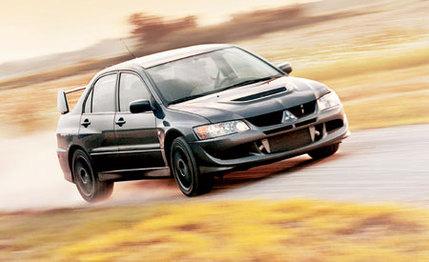
 Short Take Road Test
Short Take Road Test
Remember the musical remedy used by Jonah in the whale, Noah in the ark? Just when everything looked so dark? Taking a page from that same songbook, Mitsubishi, though tossed on stormy economic seas, chooses to accentuate the positive, and eliminate the negative.
The positive is the Lancer Evolution VIII, a low-volume, high-performance compact sedan that's already become a cult car in the U.S. The negative? Well, for all its boyish insouciance and rip-it-up verve, a weekend of Michigan back-road banditry in an Evo leaves you feeling like you've gone a couple rounds with Jackie Chan.
Other shortcomings aren't as difficult to overlook, but they do represent "improvement opportunities": turbo lag, for example, magnified by the ratios of the five-speed manual gearbox. A six-speed would allow closer ratios, making it easier to keep the engine in the let's go portion of its power band. And speaking of that, a little more let's-go is rarely unwelcome.
Meet the 2005 Mitsubishi Lancer Evolution MR Edition, an update on the Evo VIII that is certainly a step in the right direction.
Consider ride harshness. If you want information fed to your backside—detailed information—about every pavement irregularity thicker than a credit card, the Evo VIII is a superb provider. This is acceptable in a short blitz but gets old when the trip is longer than a half-hour.
The MR Edition addresses this problem with a set of Bilstein struts (front) and shocks (rear) tuned to soften the sharp edges of pavement warts. Mitsubishi says, further, that the Bilsteins manage this with no degradation in grip or transient response. Quite the contrary. And based on our experiences with this preproduction tester, we accept Mitsubishi's claims. Ride quality is still firm—you don't get feline responses without some serious stiffness—but there's a narrow comfort aisle between firm and fierce, and that's where the Bilsteins operate.
Another MR distinction is the new six-speed manual transmission with engagements almost as snick-snick precise as those in a Honda S2000. As advertised, this tranny keeps the engine closer to the meat of its output, enhanced by a lower final drive than in the Evo VIII.
We mentioned extra engine output, and it's there on all Evos, particularly on the twist side of the ledger: 276 horsepower and 286 pound-feet of torque, compared with 271 horsepower and 273 pound-feet for the previous car. The gain was achieved with a larger turbine nozzle and a new waste gate.
One other MR distinction: Those little shark-tooth fins at the rear edge of the roofline are aero elements. Mitsubishi calls them vortex generators and claims they increase rear downforce.
Other upgrades—a new helical limited-slip front differential (first seen on the Evo RS) and a new active center differential—are common to all '05 Evos. Similar to the limited slip in the Acura TL, the Evo's LSD replaces the previous open diff and improves front-end bite during hard cornering. The active center diff replaces the old viscous unit and features an electrohydraulic multiplate clutch that can send up to 50 percent of the engine's torque to the rear wheels. There are a variety of sensors, including brake application, wheel speed, steering-wheel angle, and throttle position, that inform the car's computer, which then decides how much torque to send to the rear wheels. The system also has presets for different surface conditions.
Mitsubishi makes much of various weight-saving measures in the MR—an aluminum roof panel and side-impact beams, and BBS aluminum wheels—that add up to minus 28 pounds. Still, our MR tester weighed an even 3300 pounds, 40 more than the Evo VIII we tested in June 2003.
The company puts the weight increase down to the heavier front and center differentials, but they don't seem to retard forward progress. Our MR tester hustled to 60 mph in 4.7 seconds and covered the quarter in 13.4 seconds at 104 mph. The Evo VIII clocked 60 mph in 5.0 seconds and the quarter in 13.6 at 101.
Further, the MR pulled a stout 0.94 g on the skidpad, compared with 0.90 for the Evo VIII. Since the tires are the same on both cars, we conclude the new all-wheel-drive components are doing their job.
Now for the sticker shock: Mitsubishi says "about $35,000" for the MR. We haven't seen official prices, but an '04 Evo VIII starts at $30,574. "About $35,000" bolts you into an Infiniti G35, and you get change back. So what do you really want? The G35's civilization index is higher, but the MR is the more focused performer. If that's not your priority, shop elsewhere.